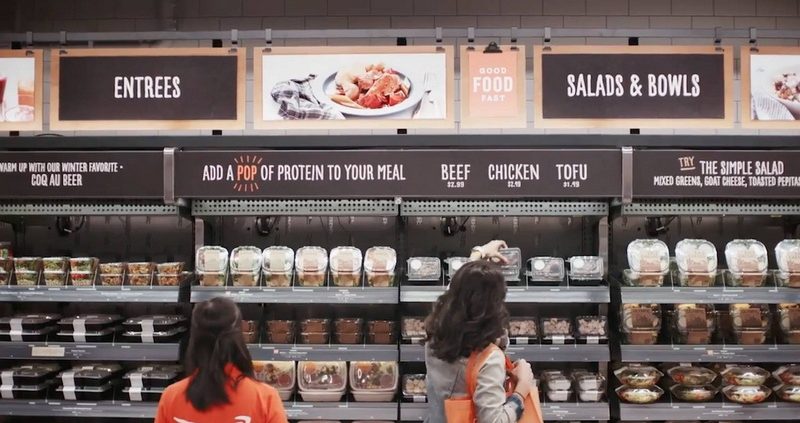Is Video a Threat to RFID?
Amazon Go is using video, which has great potential to work with RFID—but here’s why the technology cannot replace radio frequency identification.
On Jan. 21, The New York Times published an article titled “Inside Amazon Go, a Store of the Future.” The 1,800-square-foot convenience store is now open to the public (previously, it was open only to Amazon employees). The Times reporter wrote: “Every time customers grab an item off a shelf, Amazon says the product is automatically put into the shopping cart of their online account. If customers put the item back on the shelf, Amazon removes it from their virtual basket.”
How is this possible? The article went on to explain: “The only sign of the technology that makes this possible floats above the store shelves—arrays of small cameras, hundreds of them throughout the store. Amazon won’t say much about how the system works, other than that it involves sophisticated computer vision and machine learning software. Translation: Amazon’s technology can see and identify every item in the store, without attaching a special chip to every can of soup and bag of trail mix.”
The system appears to be tied to Bluetooth on a shopper’s phone. A customer would check into the store using a special Amazon Go app. The only way to add items digitally to the shopping cart would be to use locationing technology to link what that customer has pick up (and what is recognized by the cameras overhead) with the person standing in front of the shelf.
This is certainly a big achievement by Amazon, and something that could prove to be revolutionary in retail. But I don’t think the technology will ever replace RFID in retail. Rather, the two will be complementary.
There are many questions about the Amazon Go system to which we just don’t know the answer. For example, how much does the video technology cost? Look at the photo in the Times’ article. There is an awful lot of hardware in the ceiling. I would assume that over time, the technology will improve and fewer cameras will be needed, but what’s the cost?
Additionally, we don’t know how difficult it is to configure the system to each new store. Can you simply throw cameras in the ceiling and have them compare what they see to still photos uploaded to their memory banks? Or does it take time to “teach” the machine-learning system what the products are and how to handle the chaos that often occurs in stores? This is particularly an issue around the holiday season, when consumers make a mess of the shelves.
Another question I have is in regard to the cameras’ resolution. What happens, for instance, if someone picks up a product that looks very similar to another item, but one is low in sodium and the other is not? Can the cameras distinguish between the two? What if the consumer puts the low-sodium product down in the area where the regular products are stored? Will the system alert the staff that it’s in the wrong place? Will the system know when someone buys the low-sodium product, even if it was placed in the same area as the regular version? If not, the system won’t help with inventory management.
I have some other questions about the system. How well can it determine the number of items on a shelf? It should be able to alert personnel when a shelf is empty, but can it alert them to replenish when there are only three items left, so that the shelves will never be out of stock?
I have long believed that video would be used to identify bananas, watermelons and other low-priced products that can’t easily be tagged with RFID or are too inexpensive to warrant a tag. I think RFID could be used on cases of low-cost goods, and video on the individual units. But video has great limitations. It can’t tell you there are only 23 sweaters inside a box that arrives at a store, and not 24. Video can’t tell you that a wall of jeans is missing jeans with a 32-inch waist and a 30-inch inseam. It can’t tell you that there are no mediums on the rounder with pink shirts, or that a certain size of car tire is not available on the shelf.
These items are too similar for video to distinguish. Since it makes sense to tag these goods at the source and track them through the supply chain, it’s going to be far easier to put tags in labels at the point of manufacture and place readers at dock doors than it is to situate video cameras around all the shelves throughout a warehouse.
Still, the Amazon Go system is a major leap forward in retail, as customers don’t need to wait online. That’s fantastic, and I think it might work well in supermarkets and grocery stores, where the value of the items is cheap and the product packaging is clearly differentiated. Amazon deserves a lot of credit for this breakthrough. Its unique store may jumpstart innovation in retail and finally get retailers to think about the real problem with brick-and-mortar retailing: namely, that shoppers don’t find what they are looking for—and, when they do, they need to wait on a line to pay for it.
Mark Roberti is the founder and editor of RFID Journal. If you would like to comment on this article, click on the link below. To read more of Mark’s opinions, visit the RFID Journal Blog or the Editor’s Note archive.







Leave a Reply
Want to join the discussion?Feel free to contribute!